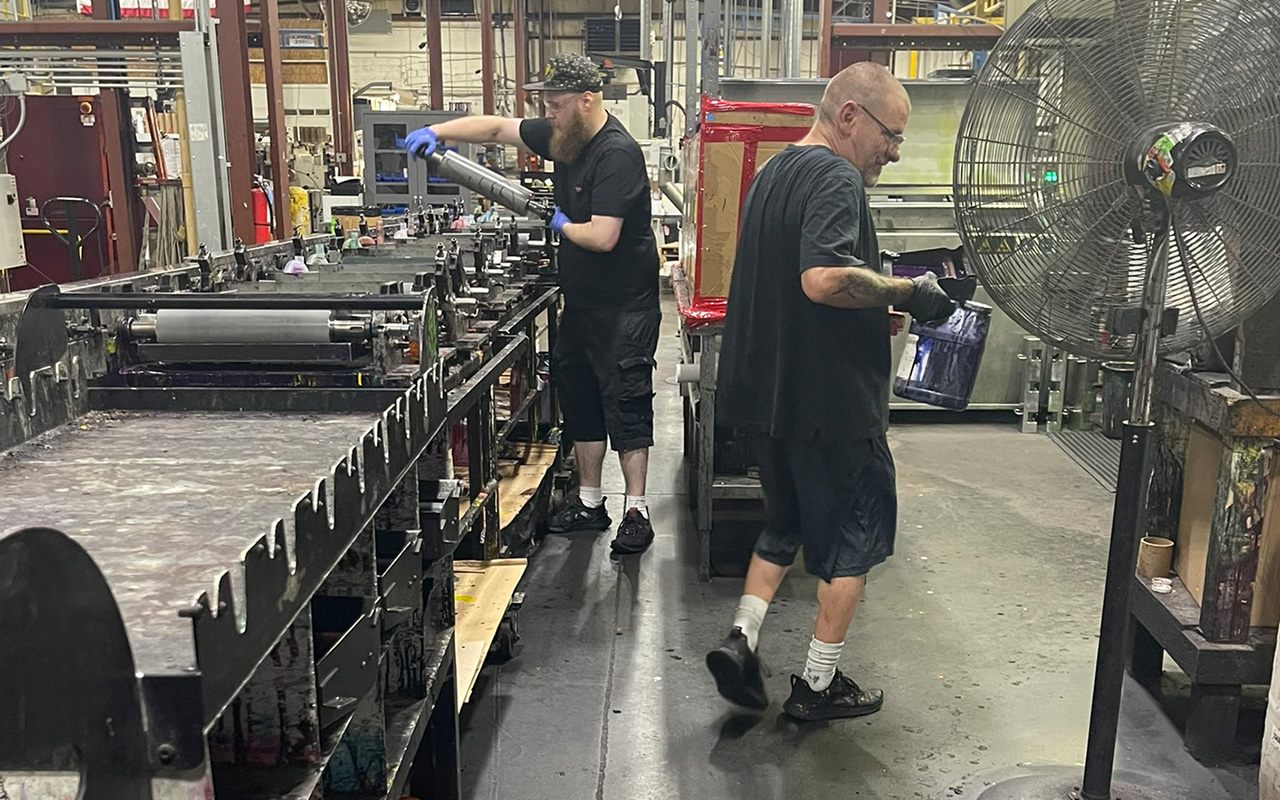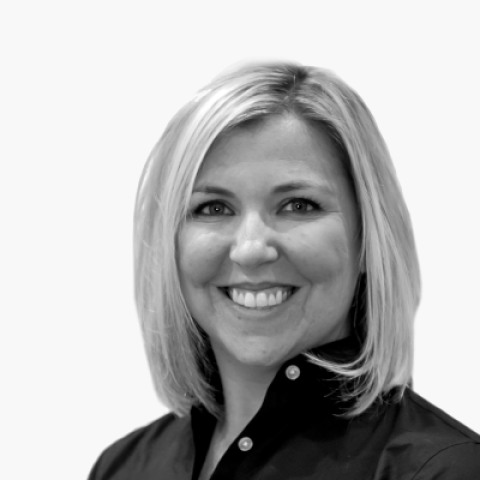KDV Label leverages automation advantage
Wisconsin-based label converter has built a business model around productivity. Now KDV Label has added capacity with digital technology as it celebrates 50 years in business.

Watching a job change at KDV Label is like watching a well-choreographed dance.
A rail-mounted tool table sweeps in along a built-in track on the floor, carrying all the tools needed for the next job. Two press operators are manning the press, but for this job change, additional team members are brought in from finishing and part washing to assist. Each team member knows their place and their role, with each person moving seamlessly through the process.
This writer is not watching a ballet performance but rather a job change at a label production facility in Waukesha, Wisconsin – the capital of the US dairy industry – at a leading converter for dairy products.
“We can’t run faster tomorrow to make up for a bad day today”
It’s this detailed choreography that allows KDV Label operators to change over a flexo press in minutes. This choreography was no accident. It was this model of efficiency that made KDV one of the best-managed companies in North America.
And it has the hardware to prove it.
The company was recently awarded a Eugene Singer Award from TLMI in the medium-sized company category. The Eugene Singer Awards are based on various metrics, showcasing KDV’s overall fi nancial performance and operational management and recognizing the best-performing TLMI converter members. It was KDV’s first such award.
One that was 50 years in the making.
Rich history
KDV Label celebrates 50 years in business in 2024. The company was started in 1974 by Karen and Dick Vaughn. The KDV origin story is one that many label converters can tell – it’s a story that begins in the family garage.
Karen and Dick ran the company successfully until their son, Shane Vaughn, took over operations in 1996. Shane led the company as it grew more than four-fold during his tenure.
The company was purchased in 2021 by Mason Wells, a Milwaukee-based private equity fi rm that owns or has owned major US packaging and converter groups such as AWT Labels & Packaging and Identco.
Shane Vaughn eventually retired from the family business in April 2023, and Walz took the top leadership position.
Today KDV Label is a USD 65M company, with aggressive plans to double its size over the next five years.
In 2016, KDV acquired iGraphics in Loveland, Colorado, and later, in 2023, acquired Selective Label in Sugar Grove, Illinois, expanding its footprint to three locations serving the entire US.
The aggressive growth plans are bolstered by Keith Walz at the helm as president and CEO, alongside Mike Brucher, president of Selective Label, Darrell O’Brien, VP of sales, and Ken Robinson, VP of operations. The executive team also includes additions from marketing, finance and sales.
Equipment
KDV Label has 21 flexo presses and four digital presses. Its newest flexo is a Mark Andy P7 press was installed three years ago. The majority of the presses have multiple installations of the same make and web width to run the same products when the company needs flexibility in its schedule or for redundancy. Thirteen turret rewinders from Martin Automatic and KTI are essential for keeping the presses moving.
KDV has moved away from a single-operator model and now operates each press as a team, so when it’s time for a press changeover, at least four individuals are there to help change inks, mount plates, mount dies, get the press in register and away they go.
‘Now it’s about managing a team rather than managing a press,’ says Walz. KDV is a leading producer of beverage labels and has built a business model based on efficiency. More than 1 million labels are printed at KDV each hour, and over 15,000 SKUs are actively managed. Keeping the presses running efficiently is critical to the company’s success.
As Robinson puts it: ‘We can’t run faster tomorrow to make up for a bad day today.’
Efficiency may be the current name of the game at KDV, but digital is its future.
Earlier this year, KDV installed the latest digital equipment from Durst, with nearline and finishing units from Grafotronic.
KDV’s Durst Tau RSCi is a 17-inch, UV inkjet printer designed for mid- to long-run jobs. Additionally, KDV sees the opportunity to run short-run jobs more economically. The machine is equipped with a chill roller and jumbo winders to sustain quality at high speeds.
‘We were looking for a high-speed digital press to fi t with the production efficiencies we’ve developed over the past five decades,’ says Robinson. ‘The Durst RSCi checked all the boxes and not only fits but enhances our production model and the way we can serve customers.’
Walz adds: ‘We did a vast assessment. We asked the press to do a lot, and we needed the speed and color consistency that was offered by Durst.’
‘The quality of these machines is mind-numbing,’ Walz continues. ‘We’ve had no issues whatsoever, and already about 5 percent of our business is going through these machines.

‘We naturally feel that the market is going in this direction. In today’s world where inventory is a bad word, and marketing departments are relying on versioning and short runs, this just gives us another leg of flexibility and allows us to penetrate other markets that demand high-quality enhanced labels.’
KDV Label has the equipment and the team, and under new leadership, it has been focusing more on another critical component: data.
The company uses EFI Radius to schedule jobs and collect data from nearly every facet of the business, guiding decisions, analyzing quality and performance and monitoring downtime.
‘We now have a better understanding of our business than we’ve had before and we have the data to back it up,’ Walz says.
Business model
One of KDV’s larger end markets is the dairy industry, but it also participates in other verticals, primarily the beverage, household, personal care and automotive markets.
The dairy industry is traditionally marked by high volumes, high mix quick turn labels that are moving through the KDV facility daily. Not to mention, these labels often must withstand harsh environments that are often cold and wet and labels that are being asked to stretch and not to wrinkle.
‘We have highly automated production lines and have invested a significant amount of capital to ensure our production process is the most effective and efficient,’ Walz says. ‘In the dairy industry, you have to be fast and furious, and that takes a lot of effort.’
Sustainability is another key aspect of the company’s success.
KDV joined the Association of Plastic Recyclers in July 2023. APR is a US-based international non-profit, and the only North American organization focused exclusively on improving recycling for plastics. APR member companies are committed to the success of recycling existing plastic into new material to reduce landfilling, plastic pollution and greenhouse gas emissions.
KDV also uses Convergen to recycle its waste matrix that is converted to energy.
Over its 50 years, the company quietly built its dairy empire in Wisconsin, all while becoming a leader in sustainability, winning awards, and keeping its customers coming back for more. Recently, the company wants to shout its good news from the rooftop.
“In today’s world where inventory is a bad word, and marketing departments are relying on versioning and short runs, this just gives us another leg of flexibility”
‘We were flying under the radar for many years,’ says O’Brien, the company’s VP of sales. ‘Nobody knew how good we are. Now we have serious marketing, so our customers and potential customers know how good we are. We are the second largest dairy label producer in the country, and it’s not just because I’m the greatest dairy salesman in the US,’ he says, laughing.
‘It’s because we have the right equipment, right leadership, the right team.’
‘When we identified and targeted the dairy market in the 1990s, we designed the production powerhouse necessary to support it,’ says O’Brien, the company’s longtime sales VP.
‘We trained our people, built the system, and invested in the equipment needed to provide the level of service and consistency necessary to succeed. In doing so, we set a new standard for that industry.
‘As we move forward and grow the business, we will replicate our world-class service and production capabilities for new customers in new markets.’
Stay up to date
Subscribe to the free Label News newsletter and receive the latest content every week. We'll never share your email address.


